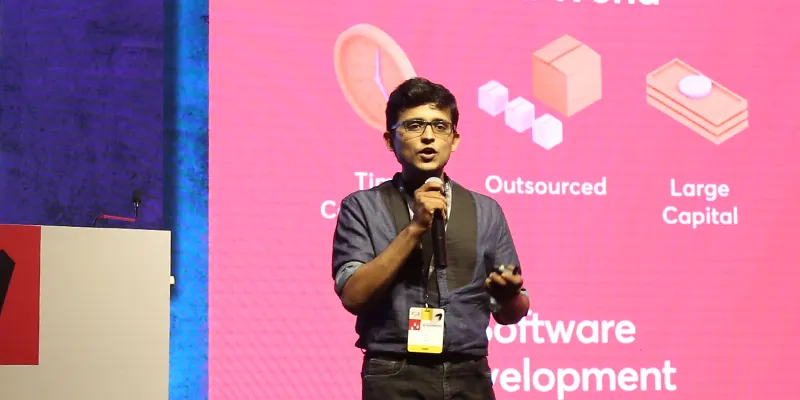[Tech30] Want to build AR and VR content? Scapic takes on the coding burden for you
With a SaaS cloud platform, Bengaluru-based Scapic, a 2018 Tech30 startup, is all set to make available AR and VR tech for greater use.
Augmented reality (AR) and virtual reality (VR) are no longer technologies of the future. They are here and now and being used in real-world cases and across industries like real estate, agriculture, tourism, healthcare and education.
But what do these terms that are bandied about with reckless abandon actually mean? A simple example of AR would be the game Pokemon Go, where reality is augmented to reflect fun enhancements. And as far as VR is concerned, think of those headsets that people don to see a world that does not yet exist - games, future layouts real-estate companies can show their potential clients etc.
So imagine the possibilities!
And Bengaluru-based Scapic, one of YourStory’s Tech30 startups, is clued in on the huge market for these technologies. It has built a unique Software-as-a-Service (SaaS) cloud platform that allows users to create and build VR and AR experiences through a web browser.

While today Scapic works as a cloud-based editor, the startup’s journey had a unique start. Founder Sai Krishna VK’s foray into AR and VR began in 2013 while he was interning at Intel after graduating from Stanford University. He realised that India was going through this massive push towards tablets in the education sector. “This was the time when Akaash tablets were bought by schools and colleges and distributed to students without them knowing much of its use,” says Sai.
Sai worked on two startups during his college days. Supertext was an AI assistant company that enabled brands and businesses to have rich, intelligent interactions with their customers. Aeriem, developed while he was doing his engineering, was an edtech initiative to digitise Indian classrooms. This is where he began developing adaptive learning supertexts available on tablets, which scoured the internet and created educational content digests. “I went to different tech schools in Bengaluru and convinced administrators to buy this content. Through this they would be able to engage and learn more,” says Sai.
All this was before he met his Scapic cofounder Ajay PV. Both Sai and Ajay are from Chennai. While Sai did his engineering at R V College of Engineering, Bengaluru, Ajay passed out of National Institute of Engineering, Mysuru. Later, Sai went on to pursue business studies at Stanford University.
From edtech to Scapic
While Ajay was working in CISCO, Bengaluru, he developed an interest in AR/VR technology and that became more prominent once he started working for San Fransisco-based VR startup Gridraster.
When Sai and Ajay met in Chennai, the conversation quickly spiralled into the question - ‘What if computers were not limited to the screen they have?’ Sai saw that computing has consistently evolved over the years, as we see more "conversational AI in the form of Alexa and more.” But even with the growth of technology, the larger audiences weren’t able to use AR, VR or AI without coding knowledge.
Ajay points out that the reason companies were not adopting AR/VR or consumers not buying VR devices is either because content creation (for companies) was costly or distribution was app-based, which took months and months of coding. “We wanted to solve this and that’s how Scapic was born in 2017,” he says.
These limitations on VR and AR proliferation pushed the duo to further work into a cloud-based editor, using which one can harness tech by just dragging, dropping and creating templates and without coding.
“The journey is more about developing foundational layers according to the shifts in the market and that’s where a startup’s patience and perseverance is tested,” Sai says.
The duo launched the beta version early in 2017 with just five members. “My morning used to be at Gridraster and nights used to pass by in developing and brainstorming for Scapic,” Ajay says. Sai had just made an exit from his earlier startup and was a fresh graduate. They both utilised their savings and bootstrapped Scapic.
They hired designers, engineers and web developers and trained them for AR/VR skills.
Creating AR/VR experiences
Scapic is now a platform that helps users create and discover AR/VR experiences. It hosts a visual interface for non-programmers and a web sandbox to build detailed experiences or 'Scapes'. The goal is to enable user-generated AR/VR content, leading to use cases ranging from walkthroughs and data visualisation to building entire connected worlds.
Scapic claims to have created 80,000 user experiences so far on their platform.
The company raised undisclosed funding in January this year, and it has also been named as one of the top 50 companies in AR/VR by Facebook. “We also worked for Asia Cup and Royal Challengers Bangalore this year,” says Sai.
On the money made so far, Ajay adds, “In the first eight months of 2017 we made a revenue of $50,000 from clients such as Myntra, LiveUp etc.” This helped them recruit more people and, today, they have a team of 20 members.
As Sai is optimistic about generating revenue, he speaks on the company’s collaboration with Airbus, Viacom18, Suresh Productions, HotStar, Sony and cricketing bodies to engage fans during matches.
Scapic follows a SaaS model with Scapic Free, which is meant for end users to get started on creating VR/AR experiences. Scapic Pro is for enterprises and professionals.
While Sai believes the industry changes with every quarter and predictions are hard to make, the concept of content is not going to die for a non-developer.
Frenzied activity, but are there takers?
While there are some big companies as competition in the space, Sai adds that the competition is significantly focused on the limited parts of the creation process.
Ever since Facebook acquired Oculus for $2 billion, VR and AR have been under the spotlight. According to CB Insights, media companies, movie studios and even VCs are looking closely at the space. The report said that over $3.4 billion has so far been pumped into space.
PlayStation’s PS Virtual Reality, a $400 headset, is on track to sell over one million units, and it is believed that Apple has over 1,000 engineers in Israel working on an AR headset.
But how is the ground reality and acceptance of these tech? “What I observe as one of the biggest hurdles in penetrating this market is resistance of user to move from 2D to 3D. Outside the gaming industry, it still has to find killer application yet,” says Sai.
The company is currently focussing on sectors such as media and entertainment, designers and fashion industry, architecture and infographics. Sai says that the platform is seeing a lot of users from the US, China and South Korea.


![[Tech30] Want to build AR and VR content? Scapic takes on the coding burden for you](https://images.yourstory.com/cs/wordpress/2018/10/Scapic.png?mode=crop&crop=faces&ar=2%3A1&format=auto&w=1920&q=75)




